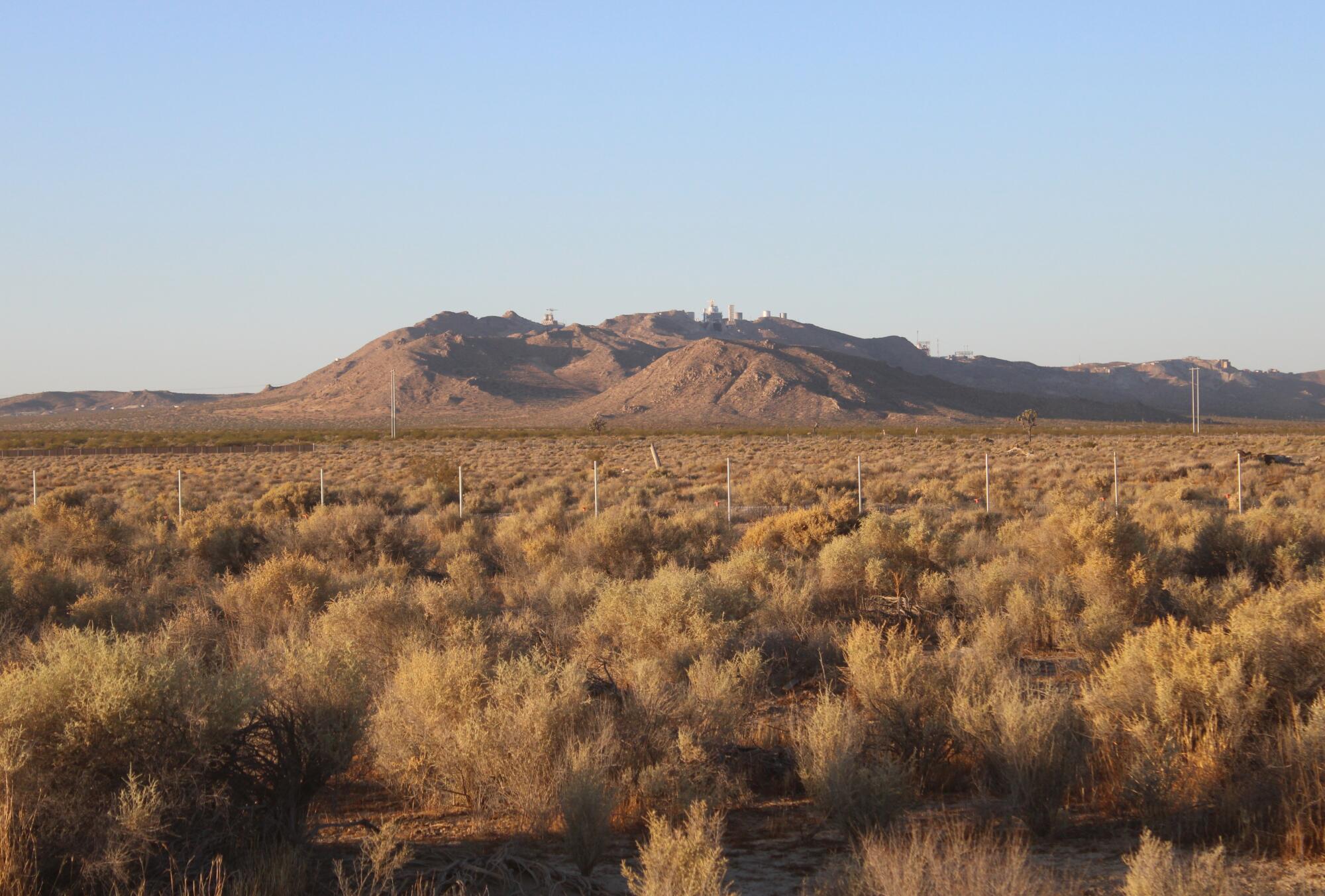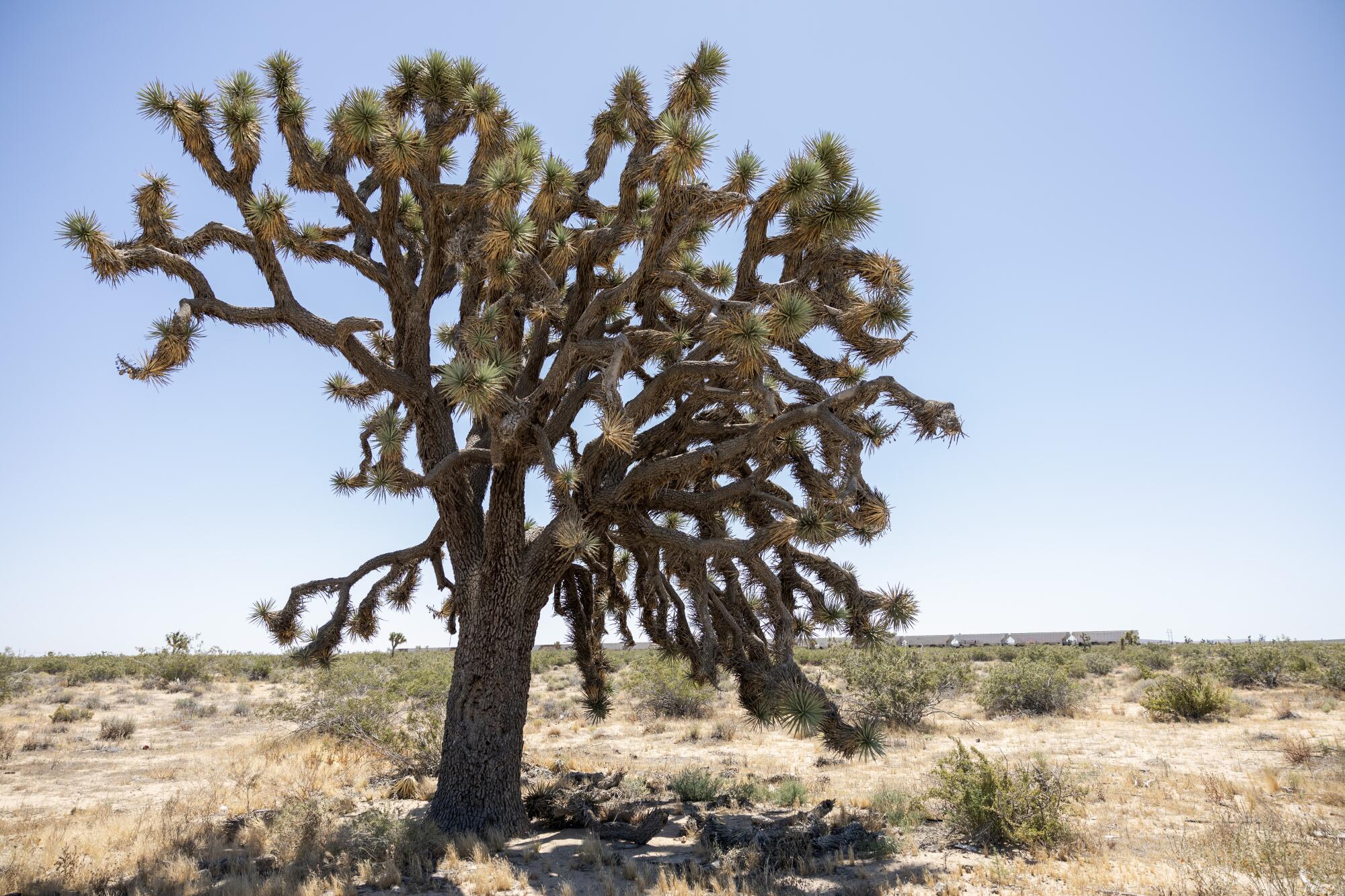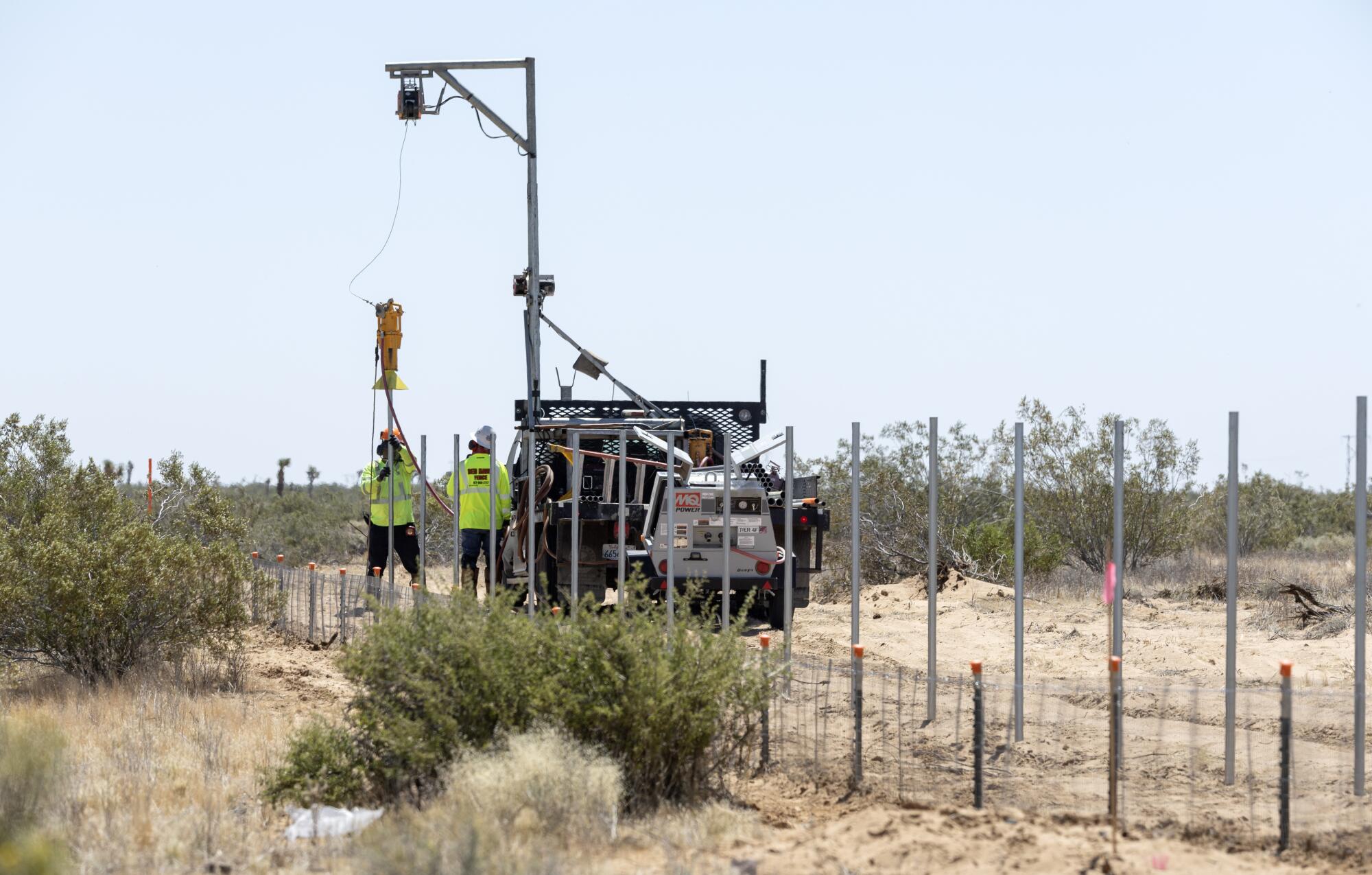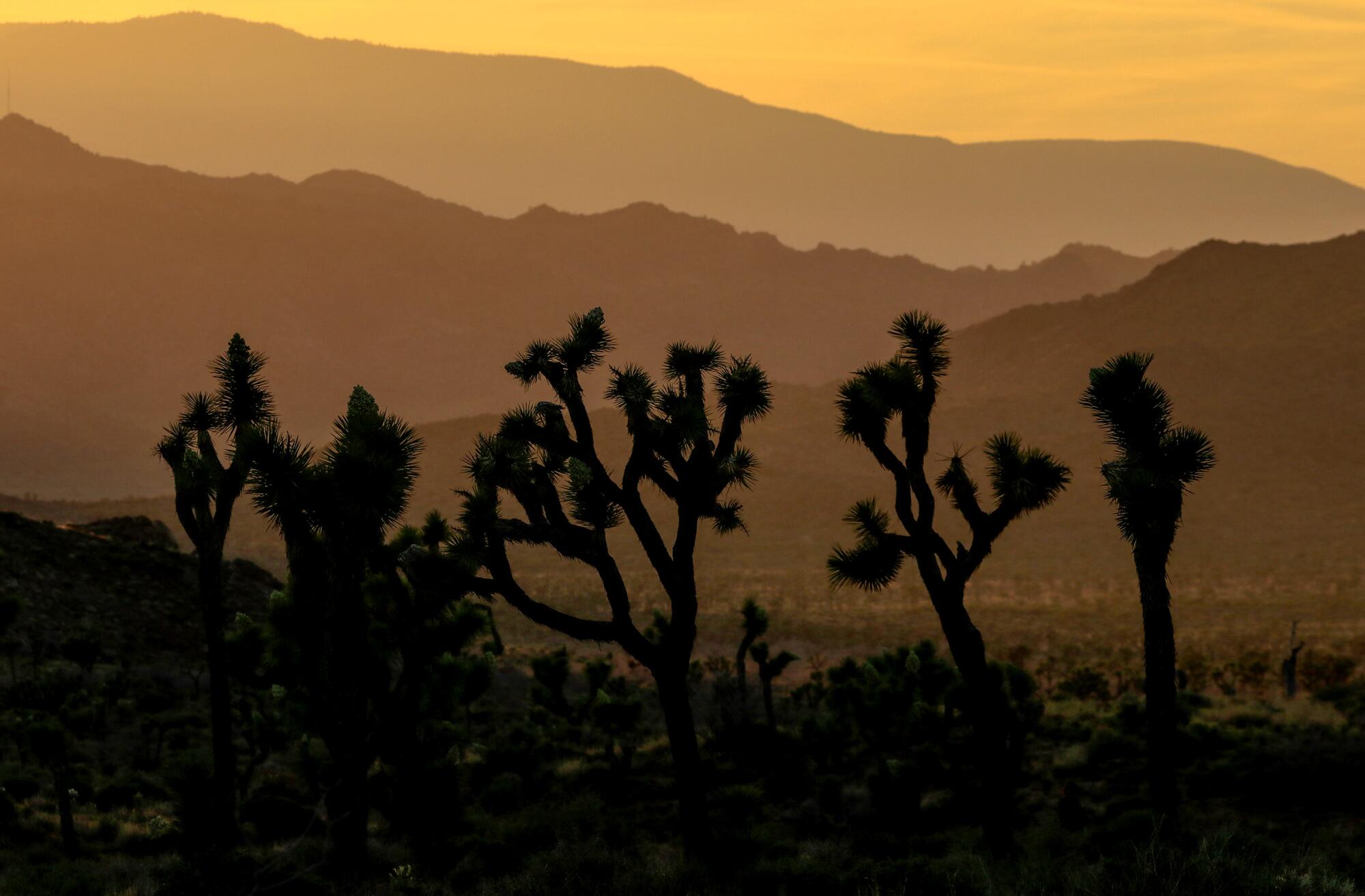
- Share via
When Roy Richards spotted workers cutting down and shredding Joshua trees for a sprawling solar energy project near his Mojave Desert home last week, he started taking photos.
“Once the trees go through the shredders, they vanish,” he said, showing a reporter an image of a small pile of brown dust left by the crews.
The developer of the Aratina Solar Center has government approval to fell all of the thousands of trees on the site. The solar energy farm won a controversial exemption from rules protecting Joshua trees four years ago after closed-door meetings between industry executives and state wildlife officials.
On Saturday, residents of nearby Boron and Desert Lake, as well as other opponents of the project, will rally to demand a halt to the project.

A 2020 survey counted 4,700 trees on the project site. Since then, however, the size of the project has been reduced.
Hundreds of Joshua trees appeared to have been destroyed in the last week, but on some portions of the site the trees still stand, residents said. Neither the company nor government agencies would say how many trees have been cut down. Avantus, the developer, said fewer trees will be destroyed than the government approved.
Heavy equipment has not yet started leveling the land where the trees were felled to prepare for the solar panel installation.
Residents fear the earth-moving work will increase the threat of valley fever — a fungal respiratory infection that is transmitted in dust. A local group found the fungus that causes valley fever in samples of topsoil from the five parcels surrounding the towns where the solar panels will be built.
“I don’t want another town to go through this,” Richards said.
Executives at Avantus say the company is following development rules set by the state and Kern County as they construct the 2,300-acre project, which is planned to produce 530 megawatts of renewable energy. They said they would keep the dust down by minimizing the grading of the land.
“Aratina will produce clean, affordable, and reliable energy for hundreds of thousands of Californians, contributing to California’s renewable energy goals,” the company said in a statement. “And as a changing climate forces Californians to endure more frequent and intense heat waves like the one we’re experiencing right now, projects like Aratina will help stabilize the grid and keep the lights on.”
Boron, where the poverty rate is twice the state average, will not get access to that green energy. Instead it will be sent hundreds of miles away to wealthier Central Coast and Silicon Valley communities, according to contracts signed earlier by the company.

The controversy over the Mojave Desert project is an example of the many trade-offs being made as California pushes for a rapid transition from planet-warming fossil fuels to renewable energy. Solar and wind fields are expected to help mitigate climate change — which is one of several factors pushing Joshua trees toward extinction — but they are also tearing up undeveloped land, harming threatened plants and wildlife and causing concern in rural communities.
“We need sustainable energy solutions that do not come at the cost of irreplaceable natural treasures,” says a petition that is trying to stop the project. The petition has been signed by more than 51,000 people.
Joshua trees create habitat for other species, and Avantus has had to work to relocate the wildlife that lives there.
The company said that biologists will be onsite throughout construction to ensure rules set by state wildlife officials are followed. Workers have been trained to notify a supervisor whenever they see wildlife.
The site is habitat for desert tortoises and Mohave ground squirrels, which are both listed as threatened under the state’s Endangered Species Act.
Avantus said that so far they have found one Mohave ground squirrel and no tortoises.
In all, 44 animal species have been found on the project site. One of those is the desert kit fox, a cat-sized canine with long delicate ears and fur on the soles of its feet to protect them from the hot sand of the Mojave.
In a 2020 survey of the site, biologists found more than 150 dens used by desert kit foxes.
According to the Center for Biological Diversity, kit fox dens are being increasingly destroyed by large-scale industrial energy development. “Even smart, climate-saving clean-energy development like solar projects are often badly sited and destroy important kit fox habitat,” the center says.

Kern County documents say that Avantus must “passively relocate” the kit foxes by blocking their dens with soil, sticks and debris. The dens are then destroyed to prevent the kit foxes from using them again as the panels are erected, according to the documents.
Avantus explained in a statement to The Times that the tactics encouraged the kit foxes to move only “temporarily” from the construction site. The company said the perimeter fence has an opening at the bottom so wildlife can return after construction.
“Solar panels can provide shade and predator protection, and we have found that kit foxes and other wildlife sometimes do migrate back to an area after construction is complete,” the company said.

The Aratina project was one of 15 solar projects that Gov. Gavin Newsom’s Fish and Game Commission voted to exempt from rules protecting Joshua trees in September 2020 using a controversial “emergency” regulation. At that time, solar executives argued that the 15 projects had already been through extensive environmental reviews and were so close to construction they were “shovel ready.”
Executives representing the 15 projects told the state repeatedly they were ready to construct and that it would be unfair to make them follow new planned Joshua tree restrictions.
In reality, executives working on Aratina had just begun the review process of the project at the Kern County planning board, according to documents. Construction did not begin until this summer — nearly four years after the county Board of Supervisors voted to approve the project.
“Clearly they were not shovel ready,” said Casey Kiernan, a photographer who lives in the town of Joshua Tree. Kiernan created the petition seeking to stop construction.

Melanie Richardson, a nurse whose sons attend schools in Boron, said it was “hard to even watch” as the crews began cutting down the trees.
She was part of a team that found the fungus that causes valley fever in soil samples taken across the site.
Richardson said she has been working on signs for Saturday’s rally, including one that says, “Why is solar more important than health.”
“Nobody wants this to happen,” she said.







